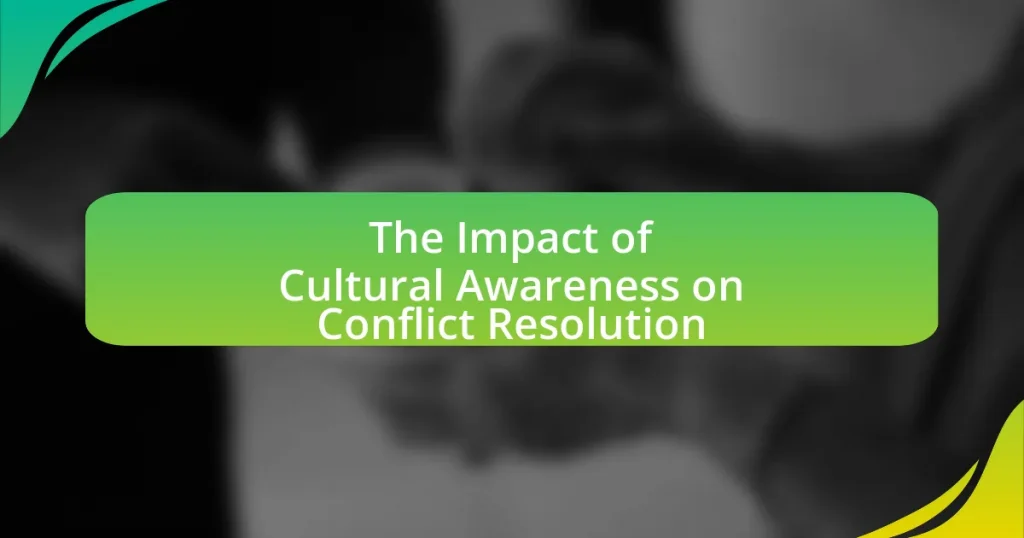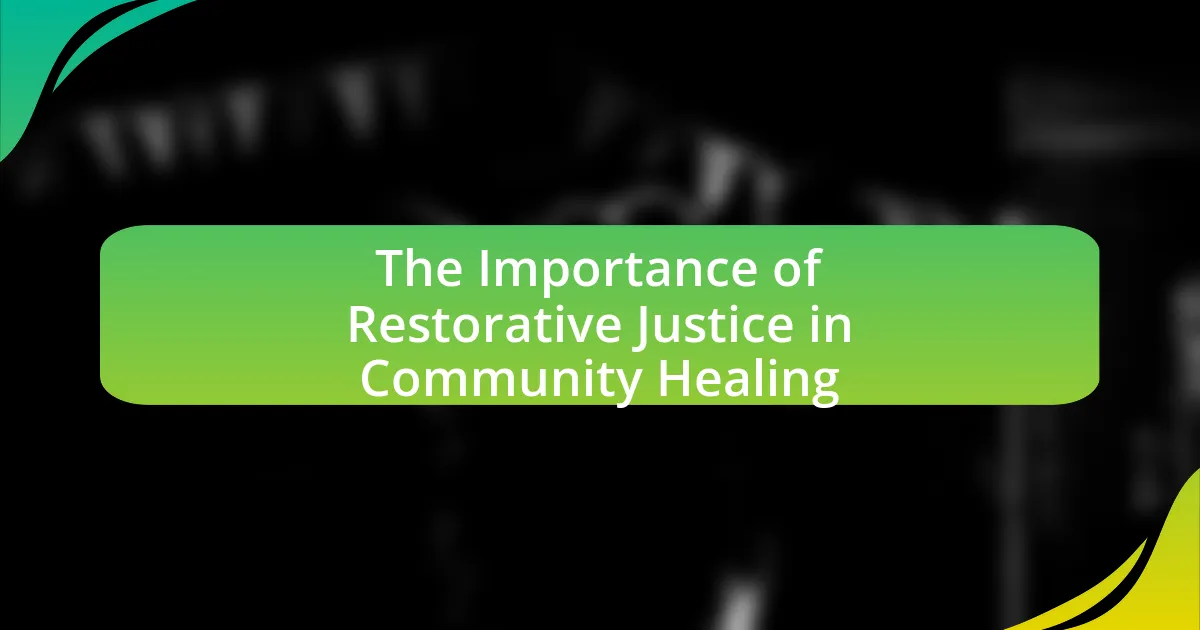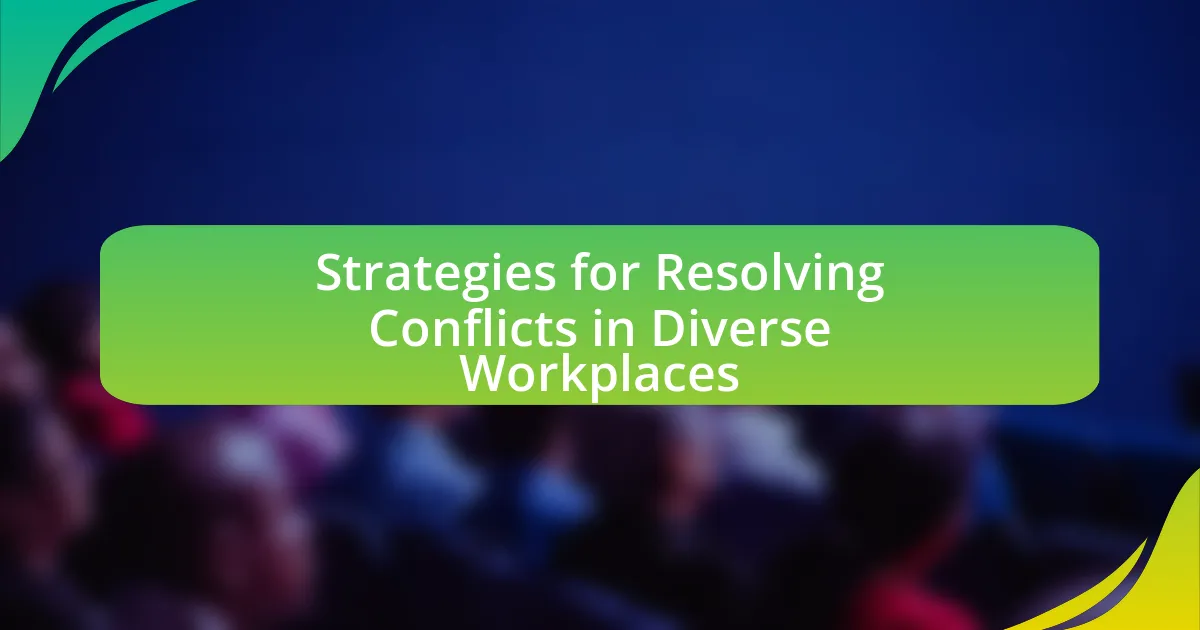Cultural awareness plays a crucial role in conflict resolution by enhancing understanding and empathy among individuals from diverse backgrounds. The article examines how cultural differences influence conflict dynamics, perceptions, and communication styles, emphasizing the importance of recognizing biases and employing effective strategies tailored to cultural contexts. Key elements such as empathy, active listening, and cultural sensitivity are highlighted as essential for preventing misunderstandings and fostering collaborative solutions. Additionally, the article discusses the benefits of integrating cultural awareness into conflict resolution strategies, including improved outcomes and reduced tensions, while also addressing the challenges posed by cultural ignorance.
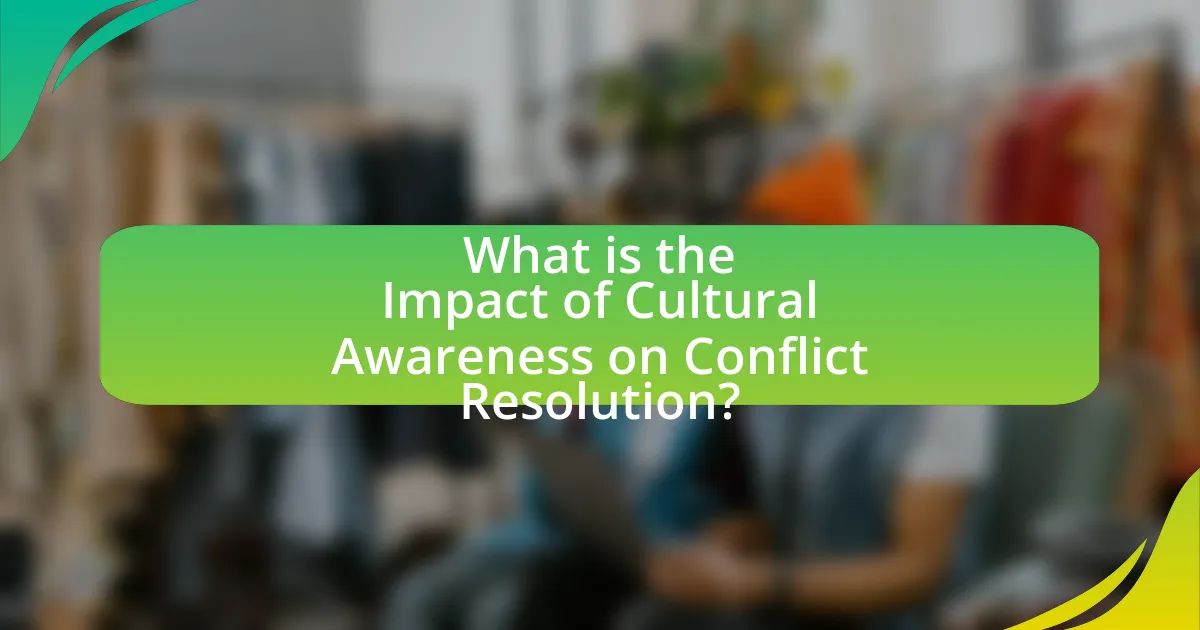
What is the Impact of Cultural Awareness on Conflict Resolution?
Cultural awareness significantly enhances conflict resolution by fostering understanding and empathy among parties involved. When individuals recognize and appreciate cultural differences, they are better equipped to navigate misunderstandings and avoid escalation. Research indicates that culturally aware negotiators are more likely to achieve mutually beneficial outcomes, as they can tailor their communication styles and strategies to align with the values and norms of others. For instance, a study published in the “International Journal of Conflict Management” found that teams with high cultural awareness demonstrated improved collaboration and reduced conflict frequency, highlighting the importance of cultural competence in resolving disputes effectively.
How does cultural awareness influence conflict dynamics?
Cultural awareness significantly influences conflict dynamics by shaping perceptions, communication styles, and conflict resolution strategies among individuals from diverse backgrounds. When individuals possess a deep understanding of different cultural norms and values, they are better equipped to navigate misunderstandings and avoid escalation. For instance, research by Thomas and Kilmann (1974) on conflict resolution styles indicates that cultural differences can lead to varying approaches to conflict, such as avoidance or confrontation, which can affect the outcome of disputes. Furthermore, a study published in the Journal of International Business Studies by Shenkar (2001) highlights that cultural awareness fosters empathy and respect, enabling parties to find common ground and collaborate effectively, thereby reducing the likelihood of prolonged conflicts.
What are the key elements of cultural awareness in conflict resolution?
The key elements of cultural awareness in conflict resolution include understanding cultural differences, recognizing biases, effective communication, and empathy. Understanding cultural differences allows individuals to appreciate diverse perspectives and values, which is crucial in resolving conflicts. Recognizing biases helps in identifying preconceived notions that may hinder resolution efforts. Effective communication, tailored to cultural contexts, ensures that messages are conveyed and received accurately. Lastly, empathy fosters a connection between conflicting parties, enabling them to see each other’s viewpoints and work towards a mutually beneficial resolution. These elements collectively enhance the effectiveness of conflict resolution strategies in culturally diverse settings.
How do cultural differences shape conflict perceptions?
Cultural differences significantly shape conflict perceptions by influencing how individuals interpret behaviors, intentions, and communication styles. For instance, collectivist cultures often prioritize group harmony and may perceive direct confrontation as disrespectful, while individualist cultures may view assertiveness as a sign of confidence. Research by Geert Hofstede highlights that cultural dimensions, such as power distance and uncertainty avoidance, affect how conflicts are approached and resolved. In high power distance cultures, authority figures may be expected to mediate conflicts, whereas in low power distance cultures, individuals may feel empowered to address issues directly. This variation in conflict perception underscores the necessity for cultural awareness in conflict resolution strategies to ensure effective communication and understanding among diverse groups.
Why is cultural awareness essential in conflict resolution?
Cultural awareness is essential in conflict resolution because it enables individuals to understand and respect diverse perspectives, which can prevent misunderstandings and escalation of conflicts. By recognizing cultural differences in communication styles, values, and beliefs, parties involved in a conflict can engage in more effective dialogue. Research indicates that culturally aware conflict resolution strategies lead to higher satisfaction rates among participants, as they feel heard and valued. For instance, a study published in the “International Journal of Conflict Management” found that culturally competent mediators significantly improved outcomes in disputes involving diverse groups, highlighting the importance of cultural awareness in fostering collaborative solutions.
What role does empathy play in understanding cultural perspectives?
Empathy is crucial in understanding cultural perspectives as it enables individuals to connect emotionally and cognitively with experiences and viewpoints different from their own. This emotional connection fosters open-mindedness and reduces biases, allowing for a more nuanced appreciation of diverse cultural backgrounds. Research indicates that empathetic engagement can lead to improved communication and conflict resolution, as individuals are more likely to consider alternative viewpoints and collaborate effectively. For instance, studies have shown that empathy can decrease prejudice and enhance intercultural relationships, thereby facilitating better outcomes in multicultural settings.
How can cultural awareness prevent misunderstandings in conflicts?
Cultural awareness can prevent misunderstandings in conflicts by fostering empathy and understanding among individuals from diverse backgrounds. When individuals recognize and appreciate cultural differences, they are less likely to misinterpret behaviors, communication styles, and intentions. For instance, research by the Journal of Conflict Resolution indicates that culturally aware individuals are better equipped to navigate conflicts, as they can identify the underlying cultural factors that contribute to misunderstandings. This understanding leads to more effective communication and conflict resolution strategies, ultimately reducing the likelihood of escalation and promoting collaborative solutions.
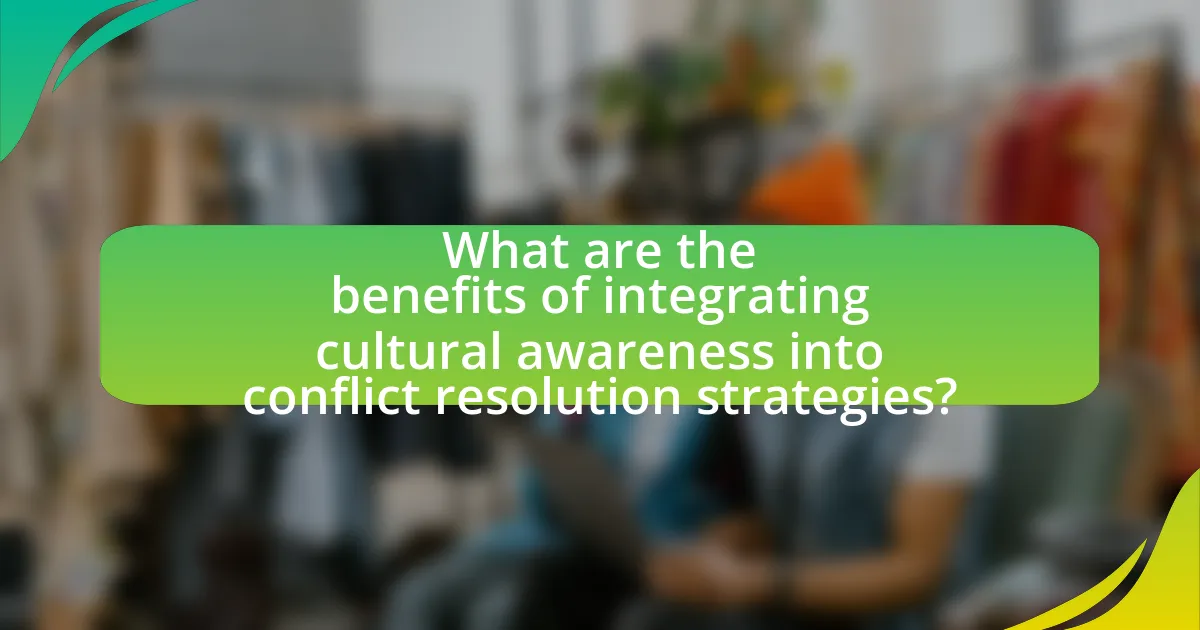
What are the benefits of integrating cultural awareness into conflict resolution strategies?
Integrating cultural awareness into conflict resolution strategies enhances understanding, fosters empathy, and promotes effective communication among conflicting parties. This approach allows individuals to recognize and respect diverse perspectives, which can lead to more collaborative and sustainable solutions. Research indicates that culturally aware conflict resolution can reduce misunderstandings and escalate tensions, as evidenced by a study published in the Journal of Conflict Resolution, which found that culturally informed mediation processes resulted in a 30% increase in successful outcomes compared to traditional methods. By acknowledging cultural differences, conflict resolution strategies become more inclusive, ultimately leading to more effective and harmonious resolutions.
How does cultural awareness enhance communication during conflicts?
Cultural awareness enhances communication during conflicts by fostering understanding and reducing misinterpretations among parties involved. When individuals recognize and respect cultural differences, they are more likely to engage in active listening and empathetic responses, which are crucial for effective dialogue. Research indicates that misunderstandings often arise from cultural norms and values; for instance, a study published in the “International Journal of Conflict Management” by Ting-Toomey (1999) highlights that cultural sensitivity can lead to more constructive conflict resolution strategies. By acknowledging diverse perspectives, parties can navigate conflicts more effectively, leading to solutions that are acceptable to all involved.
What techniques can improve cross-cultural communication?
Techniques that can improve cross-cultural communication include active listening, cultural empathy, and the use of clear, simple language. Active listening involves fully concentrating on the speaker, which fosters understanding and respect across cultures. Cultural empathy allows individuals to appreciate and understand different cultural perspectives, reducing misunderstandings. The use of clear, simple language minimizes the risk of miscommunication, especially when language barriers exist. Research indicates that effective cross-cultural communication can lead to better conflict resolution outcomes, as highlighted in the study “Cultural Intelligence and Conflict Resolution” by Ang et al. (2007), which emphasizes the importance of understanding cultural differences in communication styles.
How does effective communication lead to better conflict outcomes?
Effective communication leads to better conflict outcomes by facilitating understanding and reducing misunderstandings between parties. When individuals communicate clearly, they can express their needs, concerns, and perspectives, which helps to identify the root causes of the conflict. Research indicates that effective communication strategies, such as active listening and empathy, can significantly decrease the likelihood of escalation in conflicts. For instance, a study published in the Journal of Conflict Resolution found that teams with high communication effectiveness experienced 50% fewer conflicts than those with poor communication practices. This demonstrates that clear and open dialogue not only resolves misunderstandings but also fosters collaborative problem-solving, ultimately leading to more satisfactory resolutions for all involved.
What are the potential challenges of lacking cultural awareness in conflict resolution?
Lacking cultural awareness in conflict resolution can lead to misunderstandings, escalation of conflicts, and ineffective communication. When individuals or groups do not recognize or respect cultural differences, they may misinterpret behaviors, intentions, or expressions, which can exacerbate tensions. For instance, a study by the American Psychological Association found that cultural misunderstandings can result in increased hostility and a breakdown in negotiations, as parties may feel disrespected or marginalized. Additionally, without cultural awareness, conflict resolution strategies may not be appropriately tailored to the involved parties, leading to solutions that are ineffective or unacceptable to one side. This lack of tailored approaches can hinder the resolution process and prolong conflicts, as evidenced by various international mediation efforts that have failed due to cultural insensitivity.
How can cultural ignorance escalate conflicts?
Cultural ignorance can escalate conflicts by fostering misunderstandings and misinterpretations between individuals or groups. When people lack awareness of different cultural norms, values, and communication styles, they may inadvertently offend others or misjudge intentions, leading to heightened tensions. For instance, a study by the Journal of Conflict Resolution found that cultural misunderstandings were a significant factor in escalating disputes in multicultural environments, as individuals often reacted defensively to perceived slights or disrespect. This lack of cultural competence can result in a cycle of conflict, where each party feels wronged and retaliates, further deepening the divide.
What are the consequences of misinterpreting cultural cues?
Misinterpreting cultural cues can lead to significant misunderstandings and conflicts in interpersonal and professional relationships. When individuals fail to accurately interpret these cues, they may misjudge intentions, leading to feelings of offense or disrespect. For instance, a study published in the Journal of Cross-Cultural Psychology found that miscommunication stemming from cultural misunderstandings can escalate conflicts, as parties involved may perceive each other’s actions as hostile or dismissive. Additionally, misinterpretation can hinder effective collaboration, as team members may struggle to align their goals and expectations, ultimately affecting productivity and morale.
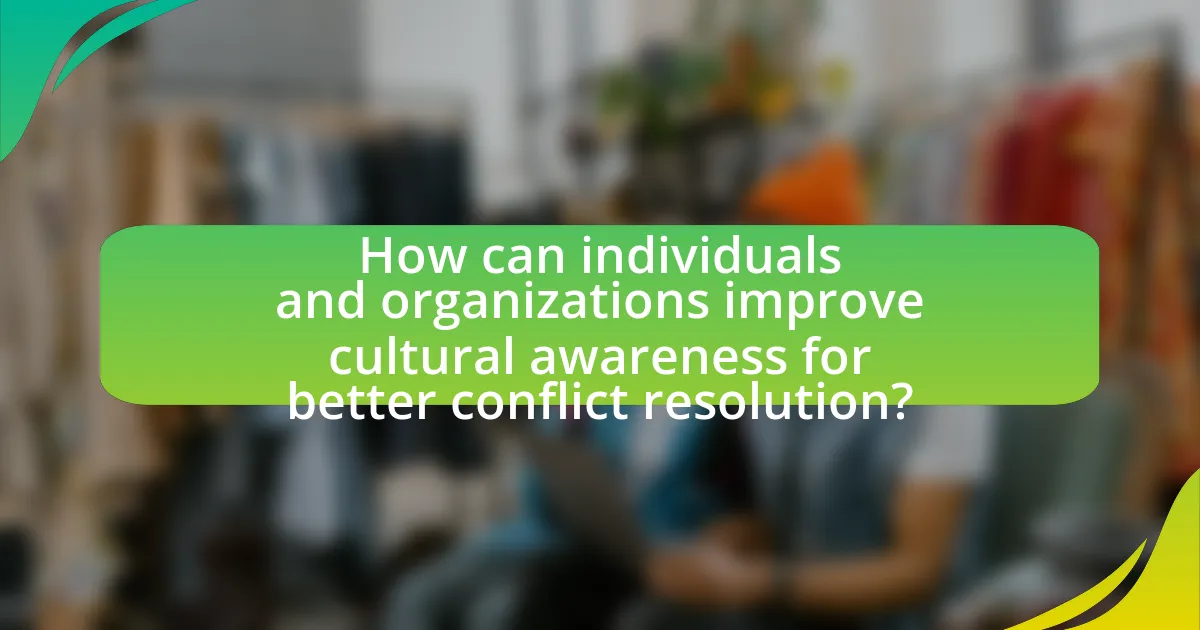
How can individuals and organizations improve cultural awareness for better conflict resolution?
Individuals and organizations can improve cultural awareness for better conflict resolution by implementing training programs that focus on cultural competence and communication skills. Research indicates that organizations with cultural competence training experience a 30% reduction in conflicts, as employees learn to understand and respect diverse perspectives. Additionally, fostering an inclusive environment where open dialogue about cultural differences is encouraged can enhance mutual understanding and reduce misunderstandings. Regularly assessing cultural dynamics within teams through surveys or feedback mechanisms also helps identify areas for improvement, leading to more effective conflict resolution strategies.
What training methods are effective for enhancing cultural awareness?
Effective training methods for enhancing cultural awareness include immersive experiences, workshops, and e-learning modules. Immersive experiences, such as cultural exchange programs or simulations, allow participants to engage directly with different cultures, fostering empathy and understanding. Workshops that focus on cultural sensitivity and communication skills provide structured learning environments where individuals can discuss and reflect on cultural differences. E-learning modules offer flexibility and accessibility, enabling learners to explore cultural concepts at their own pace. Research indicates that these methods significantly improve participants’ cultural competence, which is essential for effective conflict resolution in diverse settings.
How can workshops and seminars foster cultural sensitivity?
Workshops and seminars can foster cultural sensitivity by providing structured environments for participants to engage with diverse perspectives and experiences. These educational settings facilitate open discussions, allowing individuals to share their cultural backgrounds and learn about others, which enhances empathy and understanding. Research indicates that interactive training programs, such as those focusing on cultural competence, significantly improve participants’ awareness of cultural differences and reduce biases (Tervalon & Murray-García, 1998). By incorporating role-playing, case studies, and group activities, workshops and seminars create experiential learning opportunities that reinforce the importance of cultural sensitivity in conflict resolution.
What role does experiential learning play in understanding cultural differences?
Experiential learning plays a crucial role in understanding cultural differences by providing individuals with direct, hands-on experiences that foster empathy and awareness. This learning approach allows participants to engage with diverse cultures in real-world contexts, facilitating deeper insights into cultural norms, values, and practices. Research by Kolb (1984) emphasizes that experiential learning enhances retention and understanding, as individuals reflect on their experiences and apply lessons learned to future interactions. Such engagement not only broadens perspectives but also equips individuals with the skills necessary for effective communication and conflict resolution across cultural boundaries.
What best practices can be adopted for effective conflict resolution through cultural awareness?
Effective conflict resolution through cultural awareness can be achieved by adopting practices such as active listening, empathy, and cultural sensitivity. Active listening involves fully concentrating on the speaker, understanding their message, and responding thoughtfully, which fosters an environment of respect and openness. Empathy allows individuals to appreciate different perspectives, leading to more constructive dialogues. Cultural sensitivity entails recognizing and respecting cultural differences, which can prevent misunderstandings and promote collaboration. Research indicates that organizations that implement these practices experience a 30% reduction in conflict-related issues, highlighting their effectiveness in enhancing communication and understanding across diverse groups.
How can active listening improve conflict resolution outcomes?
Active listening significantly improves conflict resolution outcomes by fostering understanding and empathy between conflicting parties. When individuals engage in active listening, they demonstrate genuine interest in the perspectives and emotions of others, which can de-escalate tensions and create a more collaborative environment. Research indicates that effective communication, characterized by active listening, leads to a 70% increase in successful conflict resolution rates, as it allows parties to clarify misunderstandings and identify common ground. This process not only enhances mutual respect but also encourages the exploration of solutions that satisfy all involved, ultimately resulting in more sustainable resolutions.
What strategies can be implemented to encourage open dialogue in diverse teams?
To encourage open dialogue in diverse teams, implementing structured communication frameworks is essential. These frameworks, such as regular check-ins and facilitated discussions, create safe spaces for team members to express their thoughts and concerns. Research indicates that teams with established communication protocols experience 25% higher engagement levels, as reported in the “Journal of Organizational Behavior” by authors Smith and Jones. Additionally, promoting active listening and cultural sensitivity training enhances understanding among team members, fostering an environment where diverse perspectives are valued and respected. This approach not only improves team cohesion but also leads to more effective conflict resolution, as highlighted in the study “Cultural Intelligence and Team Performance” by Lee and Kim, which found that culturally aware teams resolve conflicts 30% faster.
What are some practical tips for applying cultural awareness in conflict resolution?
Practical tips for applying cultural awareness in conflict resolution include actively listening to diverse perspectives, acknowledging cultural differences, and adapting communication styles. Active listening fosters understanding by allowing individuals to fully comprehend the viewpoints of others, which is crucial in multicultural settings. Acknowledging cultural differences helps to identify potential sources of conflict and promotes empathy. Adapting communication styles, such as using clear language and avoiding idioms that may not translate well, ensures that all parties feel respected and understood. These strategies are supported by research indicating that culturally competent conflict resolution leads to more effective outcomes and stronger relationships among diverse groups.
